The Challenge
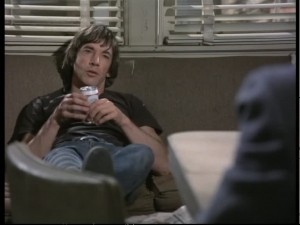 It’s not that hard to imagine a young Steven Seagal, pre-ponytail, chins, and widow’s peak, thinking of himself as the most important crew member on the set of John Frankenheimer’s The Challenge. Hired to do the Akido stuntwork, Seagal could easily see himself as Scott Glenn’s lead character, the towering white American respectfully learning all he can from the wise and wily Japanese. Of course, it becomes a lot funnier if you imagine Seagal with the moppet hair that Glenn sports throughout The Challenge, as if an oversized Seagal were doing a guest spot as one of the young children on Eight is Enough.
It’s not that hard to imagine a young Steven Seagal, pre-ponytail, chins, and widow’s peak, thinking of himself as the most important crew member on the set of John Frankenheimer’s The Challenge. Hired to do the Akido stuntwork, Seagal could easily see himself as Scott Glenn’s lead character, the towering white American respectfully learning all he can from the wise and wily Japanese. Of course, it becomes a lot funnier if you imagine Seagal with the moppet hair that Glenn sports throughout The Challenge, as if an oversized Seagal were doing a guest spot as one of the young children on Eight is Enough.
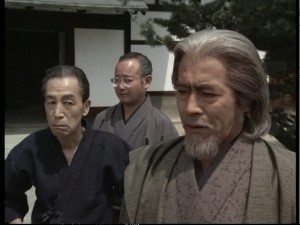 Fortunately, Frankenheimer’s film is legitimately more respectful than a self-indulgent Seagal fantasy. The crude cruelty of America makes a cameo in the film, early on when Glenn, as Rick, a bottom-of-the-heap boxer, smarms his way out of a job as a sparring partner for a Japanese fighter and into a job as a low-rent sword courier. The first villain he comes across, played by the feather-haired Calvin Jung, sports an accent that can only be categorized as a very broad impersonation of Edward G. Robinson. “It’s a phony sword, see.” Jung is supposed to represent what happens when a Japanese man becomes corrupted by outside society, he becomes a gangster who loathes everything about his home country. He’s Glenn’s Ugly American turned inside out.
Fortunately, Frankenheimer’s film is legitimately more respectful than a self-indulgent Seagal fantasy. The crude cruelty of America makes a cameo in the film, early on when Glenn, as Rick, a bottom-of-the-heap boxer, smarms his way out of a job as a sparring partner for a Japanese fighter and into a job as a low-rent sword courier. The first villain he comes across, played by the feather-haired Calvin Jung, sports an accent that can only be categorized as a very broad impersonation of Edward G. Robinson. “It’s a phony sword, see.” Jung is supposed to represent what happens when a Japanese man becomes corrupted by outside society, he becomes a gangster who loathes everything about his home country. He’s Glenn’s Ugly American turned inside out.
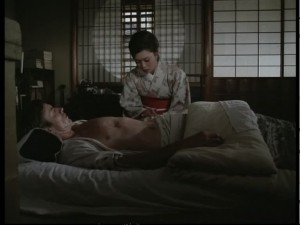 Unfortunately, some of these cruder touches seep into other elements of the film, such as a cheesy, seppuku-worthy sex scene, likely inserted by the producer Robert L. Rosen, who bookended The Challenge with projects like Going Ape and Porky’s 3: Revenge. That Frankenheimer continued to work with Rosen is sad, but at least he took a 7 year break from their partnership after The Challenge. It feels like a cynical move anyway to attempt the fish-out-of-water, “Eastern-Western” that Rosen was likely after. The Challenge posits Glenn in the role of a white savior, going from morally bankrupt and crass, to curious but still corruptible, and making the turn at knowledge and redemption, through comedic training sequences. The thing is, you can’t play the White Savior game at the same time as the Ugly American game, and so it’s not the least bit believable that Glenn attains skills that would have taken more graceful men years to earn. The White Savior genre requires the main character have all of the plot twists and turns surround him, with his final learning of lessons from the poor, grateful, and anonymous Yellow/Brown people be the conclusion of his arc.
Unfortunately, some of these cruder touches seep into other elements of the film, such as a cheesy, seppuku-worthy sex scene, likely inserted by the producer Robert L. Rosen, who bookended The Challenge with projects like Going Ape and Porky’s 3: Revenge. That Frankenheimer continued to work with Rosen is sad, but at least he took a 7 year break from their partnership after The Challenge. It feels like a cynical move anyway to attempt the fish-out-of-water, “Eastern-Western” that Rosen was likely after. The Challenge posits Glenn in the role of a white savior, going from morally bankrupt and crass, to curious but still corruptible, and making the turn at knowledge and redemption, through comedic training sequences. The thing is, you can’t play the White Savior game at the same time as the Ugly American game, and so it’s not the least bit believable that Glenn attains skills that would have taken more graceful men years to earn. The White Savior genre requires the main character have all of the plot twists and turns surround him, with his final learning of lessons from the poor, grateful, and anonymous Yellow/Brown people be the conclusion of his arc.
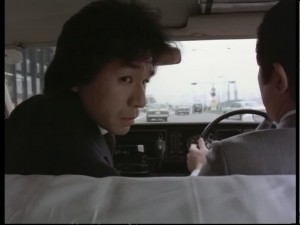 Luckily, co-writer John Sayles, who had been by that point, knee deep in his self-aware exploitation period (writing Piranha, The Howling, and Alligator), was moving towards his more respectable career as an independent filmmaker. You can spot Sayles touches throughout The Challenge, as with the themes of self-doubt and honor that would later show up in his own Men With Guns and Lone Star. Sayles seems more interested in the backstory behind Toshiro Mifune’s character, and his battles with his brother, as if getting Glenn to Japan was just an excuse to tell that story, and he’d be more than happy to kill him off. The scene where, after the standard “foreign foods are icky” gross-out scene (played more effectively in Indiana Jones and the Temple of Doom), Glenn drunkenly goes off to vomit, might have been a good turning point to leave Glenn behind and move on to the actual story. Sayles’ fingerprints are visible in the transition between Act I and II, where Glenn has left the story, but can only find his redemption through full assimilation. Granted, this is hacky material, but Frankenheimer excels in pulpy nonsense like The Challenge, and the surprisingly brutal violence that makes an occasional appearance is well handled.
Luckily, co-writer John Sayles, who had been by that point, knee deep in his self-aware exploitation period (writing Piranha, The Howling, and Alligator), was moving towards his more respectable career as an independent filmmaker. You can spot Sayles touches throughout The Challenge, as with the themes of self-doubt and honor that would later show up in his own Men With Guns and Lone Star. Sayles seems more interested in the backstory behind Toshiro Mifune’s character, and his battles with his brother, as if getting Glenn to Japan was just an excuse to tell that story, and he’d be more than happy to kill him off. The scene where, after the standard “foreign foods are icky” gross-out scene (played more effectively in Indiana Jones and the Temple of Doom), Glenn drunkenly goes off to vomit, might have been a good turning point to leave Glenn behind and move on to the actual story. Sayles’ fingerprints are visible in the transition between Act I and II, where Glenn has left the story, but can only find his redemption through full assimilation. Granted, this is hacky material, but Frankenheimer excels in pulpy nonsense like The Challenge, and the surprisingly brutal violence that makes an occasional appearance is well handled.
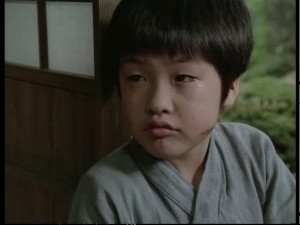 Frankenheimer, whose career, after his heyday in the 1960s (The Manchurian Candidate, Birdman of Alcatraz), had hit a lull after 1979’s hokey horror film Prophecy, obviously wanted to garner some goodwill with The Challenge, which explains his hiring of Cinematographer Kôzô Okazaki, who worked primarily on Japanese language projects, but also shot The Yakuza. That was Sydney Pollack’s 1974 film that mined similar territory as The Challenge, with Robert Mitchum playing the tough honky role, sloppily wading his way through Japan and learning the meaning of honor. Okazaki doesn’t bring a visual crispness to either film, but rather a hazy, lived-in feel, even utilizing the same extraordinary building he used in The Yakuza, for the final battle in The Challenge (clearly an influence on the similar conclusion in the Shô Kosugi vehicle, Revenge of the Ninja). The knowing feel of the photography is best expressed in an early chase scene where Frankenheimer repeatedly flash cuts to fish heads as Glenn grimaces as he runs. It’s grimy, off-putting, and just right for the moment.
Frankenheimer, whose career, after his heyday in the 1960s (The Manchurian Candidate, Birdman of Alcatraz), had hit a lull after 1979’s hokey horror film Prophecy, obviously wanted to garner some goodwill with The Challenge, which explains his hiring of Cinematographer Kôzô Okazaki, who worked primarily on Japanese language projects, but also shot The Yakuza. That was Sydney Pollack’s 1974 film that mined similar territory as The Challenge, with Robert Mitchum playing the tough honky role, sloppily wading his way through Japan and learning the meaning of honor. Okazaki doesn’t bring a visual crispness to either film, but rather a hazy, lived-in feel, even utilizing the same extraordinary building he used in The Yakuza, for the final battle in The Challenge (clearly an influence on the similar conclusion in the Shô Kosugi vehicle, Revenge of the Ninja). The knowing feel of the photography is best expressed in an early chase scene where Frankenheimer repeatedly flash cuts to fish heads as Glenn grimaces as he runs. It’s grimy, off-putting, and just right for the moment.
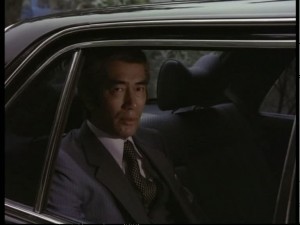 Were the fish heads a nod to the Barnes and Barnes song Fish heads, and their roly-poly-ness? Unlikely, but certainly Steven Seagal took their lead on the issue of being a roly-poly action star. Yep. Fat joke.
Were the fish heads a nod to the Barnes and Barnes song Fish heads, and their roly-poly-ness? Unlikely, but certainly Steven Seagal took their lead on the issue of being a roly-poly action star. Yep. Fat joke.



